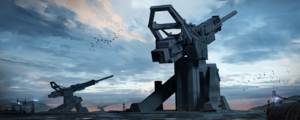HALOS (Hyboria)
| Rifle, 48-inch, M8 | |
|---|---|
 3 examples shown on Barbette Mount M13 | |
| Type | Low-orbital hypervelocity asteroid interception and air and ballistic missile defense |
| Place of origin | Hyboria |
| Service history | |
| In service | 1987- |
| Used by | Hyboria |
| Wars | Omandan Continental War |
| Production history | |
| Designer | Dr. William Atkinson |
| Designed | 1970 |
| Manufacturer | Various |
| Unit cost | 20 Billion dollars |
| Produced | 1982-1990 |
| No. built | 8 |
| Specifications | |
| Shell weight | 2 tonnes |
| Caliber | 1,200 mm (47 in) |
| Elevation | +80° -15° |
| Traverse | 360° |
| Rate of fire | 1 round every 5 minutes |
| Muzzle velocity | 6 km/s (20,000 ft/s) |
| Effective firing range | 1,500 km (930 mi) |
| Maximum firing range | 2,000 km (1,200 mi) |
| References | |
The Hyborian Anti Low Orbital System, also known as HALOS or by its project name, Project Stonehenghe is a low-orbital hypervelocity asteroid interception and strategic air and ballistic missile defense system developed and built in Hyboria. The system was developed initially to combat low-orbital debris and asteroid impacts following the planetfall of the Ulysses Asteroid in the 1910s and subsequent years following. During the events of the Omandan Continental War its use as an anti-air and missile defense system was also unveiled. Upon entry in early 1987, the HALOS was used against a large formation of Transnapistani bomber aircraft using a low-yield nuclear munition, the existence of which had been kept a secret to the world. The guns would go on using their standard ammunition for engagements until the 1994 nuclear exchange. Then the system would also show its use as a ballistic missile defense system, shooting down Transnapistani MRVs with their low-yield nuclear shells, greatly reducing effectiveness of the nuclear strike on Hyboria.
It is the largest artillery gun in the world, uses the largest supercomputer in the world and is the only major operational light-gas gun in service in the world.